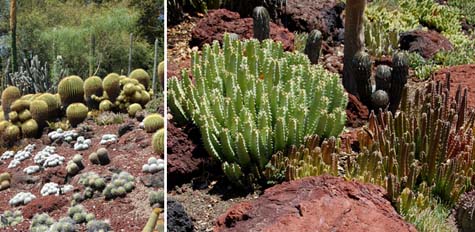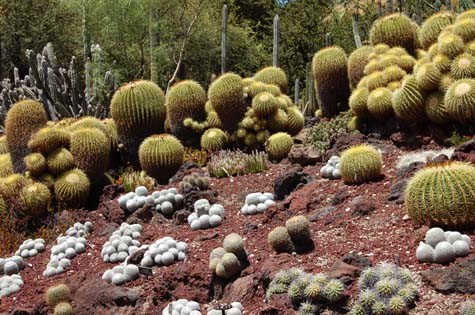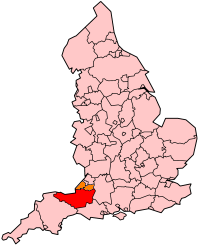Some thoughts on desert gardens
 [Images: Cacti at the Huntington Library in Pasadena].
[Images: Cacti at the Huntington Library in Pasadena].My wife and I went out to the Huntington's Desert Garden yesterday. I have to admit to a certain wild amount of enthusiasm for high-end botanical environments like that.
Being a fan of Kew Gardens, for instance, or Longwood Gardens, or even small local greenhouses and the like, I have a huge soft-spot for regions of the Earth's surface that have been deliberately cultivated to support rare – or at least highly condition-dependent – plantlife.
In the case of Kew and Longwood, you walk through elaborate, mist-filled greenhouses, passing orchids and ferns – but the word greenhouse is actually a form of structural shorthand, saying, in fact, that architecture has been put to use in the evolutionary hybridization of plantlife: flowers, fruits, and other animate forms that would, naturally, have grown elsewhere.
By establishing micro-climates, with often extreme variation from building to building, in both temperature and humidity, architecture participates directly in botanical speciation.
 [Image: Cacti at the Huntington Library in Pasadena].
[Image: Cacti at the Huntington Library in Pasadena].In any case, these thoughts don't actually apply to the Huntington Desert Garden, which is entirely outdoors – or, at least, the part of it that we visited was entirely outdoors, in the dry heat of a spectacular, arm-sunburning day – but no matter: either way, it's hard to have a bad time walking around in the Huntington's linked network of curved paths past biomorphically avant-garde cacti and spiked trees so surreal they appear literally extraterrestrial.
Briefly, all of this reminds me of an incredible fact I read last week in the London Review of Books: Stefan Buczacki, the author of Garden Natural History, has "calculate[d] that private gardens [in England] occupy an area about the size of Somerset, and they play an important part in maintaining the populations of many species."
 [Image: Somerset County, England].
[Image: Somerset County, England].That is to say: an area in England the size of Somerset is actually a kind of biological transplant: a deliberately cultivated micro-climate, or genetic testing site, with its own yet to be calculated effects both on native plants and animals and on the British climate.
At what point, then, do privately held and cultivated landscapes become naturalized as a region's terrain, or as part of that region's native biosphere?
It's a surrogate, or prosthetic, ecosystem – a kind of skin graft – masquerading as the thing that's been replaced.
Think of it as the English family garden as replicant.
In other words, if English private gardens proliferate to the point where an area not just the size of Somerset County, but of, say, Somerset, Wiltshire, and Gloucestershire combined, then do artificial landscapes become indicative of England itself?
Or, to use an absurd analogy, if the band Napalm Death now has no connection to the original band – because all of the original members have left – indeed, as Wikipedia points out, "by the second side of their debut album... they did not contain any original members" – is it possible that, in a thousand years' time, or in five thousand years' time – or even in fifty – that "England" will soon be England in name only, having been slowly replaced, piece by piece – a garden here, a garden there – until the Britannic landscape is entirely manmade and it's become impossible to locate even a trace of native vegetation? A kind of ecological bait-and-switch?
You book a trip to England – but you're visiting an island made entirely from private gardens, a vast, unnatural landscape ruled over by a King.
In any case, the Huntington Desert Garden is a spectacular place to visit, and as good a place as any in which to think about the local cultivation of non-native landscapes. So if you're ever in Los Angeles, consider stopping by.
(Earlier on BLDGBLOG: Kew Brew, or: turning endangered landscapes into beer).





Comments are moderated.
If it's not spam, it will appear here shortly!
Have you read Last Chance to See by Douglas Adams? It's not very well known compared to Hitchhiker's Guide to the Galaxy, but it was his favorite, amongst the books he wrote, and I quite like it as well.
It's primarily about endangered species, but it has a number of themes I think you would find interesting. Like endemic vs. exotic plants, like you're talking about; how the tame privet bushes in England are considered really invasive in other places.
There's also an interesting bit about how it seemed to him that plants an animals in an area look like that area on a macroscopic scale, specifically the Komodo dragon looking like the islands they live on when seen from afar.
It's interesting (well, interesting to me) how very wrong it seems to see Somerset referred to as 'Somerset County'. It makes it sound like something from Dukes Of Hazzard.
How many percent of the Britannic landscape are not deeply influenced by man? I mean, gardens may be the extreme, but cities, agriculture, cultivated forests and managed wildernesses aren't that pristine, too.
I saw an artwork at Griffith Park, years ago, that labeled plants with their identity and place of origin. None of the plants he chose to label were native. Weeds, bushes, trees, invaders from far corners of the globe. Brought here intentionally or piggybacking with other freight.
What I mean to point out is your vision of the completely darned sock is well on the way to fulfillment, tended gardens not neccesary.
I'll be the first to admit, actually, that this post speculates about something that has more or less happened already - which is the artificialization of the natural environment in England.
And, while writing the post, it did also occur to me to point out that the amount of paved space in England - car parks, motorways, cul-de-sacs, feeder roads, high streets - is surely larger than Somerset, and, thus, even more of an imposed ecosystem than private gardens.
Paved space as niche ecosystem.
I learned to love cacti after I visited the Huntington Gardens. The round cacti you see in the pictures are Echinocactus grusonii, or golden barrel cacti. They grow slowly and don't bloom until they are quite old so these specimens may be up to fifty years old. I had one for a while but unfortunately killed it by poor maintenance.
Don't forget the even more artificial indoor gardens kept by people like me who have no outdoor garden space. In the desert of my apartment, cacti now thrive next to rainforest weeds such as spathyphyllium and pothos ivy.
I've had the opportunity to talk to a few people about the immigration dissusion in the American southwest.
I asked them: Are you as native as the tumbleweed?
Some of them caught on. Tumbleweed came from the Eurasian steppes, seeds stuck to the clothing of Russian immigrants in the 1800s. (The immigrants who contributed to the American Dust Bowl, possibly the worst ecological catastrophe in history, but that's a whole other story and has nothing to do with architecture).
Now we think of tumbleweed as representing the American west, but before the 1800s, it wasn't to be found on the continent. Does that answer your question? :-)
We also think of crop plants as somehow 'native,' though clearly they're not. If you look at the Palouse in western Washington, for instance, you'll find hilly grasslands transformed into some of the most productive wheat-growing farms on the continent. A huge garden, but not grown for aesthetics.
is it possible that, in a thousand years' time, or in five thousand years' time – or even in fifty – that "England" will soon be England in name only
"This axe has been in my family for five generations. In all those years, we've only replaced the head twice, and the handle three times."
Somewhat OT, but yesterday I was reading a tourist site that catalogs Christian landmarks in the Holy Land. Very few of them are authentic, needless to say, but they exist nonetheless because...well, because they must.
I was especially interested in the Via Dolorosa, which travels from one arbitrary point to another by means of varying paths (adherents of different churches turn east or west at certain spots, as orthodoxy requires).
The combination of the concrete and the hopelessly vague is kind of fascinating....
I bet you an acre of exotic tumbleweed that BLDGBLOG can make innumerable arguments that the dust bowl was, indeed, an architectural catastrophe!
So a Somerset-sized chunk of England is gardens... but a chunk of Earth two times the size of England was covered with GM crops by 2000: "Worldwide, about 670 million acres of land are under cultivation, of which 16 percent consisted of GM crops in 2000. (This area, 109.2 million acres, corresponds to almost twice the size of the United Kingdom.)" (From the Pew Intitiative). Not just anthropogenic landscapes, but genescapes as well...
Wow - in which case it's an area not just two times the size of England, but two times the size of England, Wales, Scotland, and Northern Ireland. Good lord. An archipelago of the genetically-altered.
And interesting points, Phila.
In Australia they are also working on the 'biological transplant'. Here and elsewhere
"…Most gardens reject the local environment."
http://mnly.blogspot.com/2006/04/on-gardening-mind.html
It is about reducing rich biodiversity into a (usually petrol & chemical aided) impoverished monocultural land-scape.
Not entirely unrelated is the concept of the "anthropogenic climax", which if I recall correctly is an idea attributed to the British ecologist Tansley.
Regardless of who it's attributed to, the anthropogenic climax is similar to the traditional ecological concept of a climax, in that it is a collection of (relatively) stable communities of organisms. It differs in that the anthropogenic climax is maintained not by an intrinsic balance of energy flows, but by the consistent and even application of human intervention.
Though you might be able to shoehorn monocultures like lawns into fitting the definition, it more typically refers to something like the ecology of the traditional English countryside, where a diverse mix of plant and animal species depend on opportunities created by human intervention (such as rabbits, who make their homes in the hedgerows), but probably not on the massive application of chemical or energy inputs. Worster's "Nature's Economy" provides a better overview than I have. Lately, I've been quite interested in the potential for new, intentional anthropogenic climaxes (despite the fact that the whole notion of a climax is rather out of fashion in ecology lately).
Post a Comment